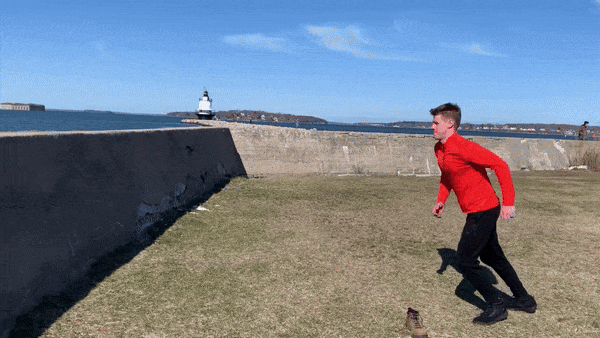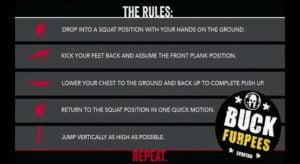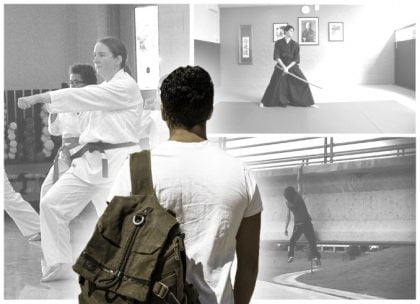Unlock exciting ninja parkour skills! Designed for complete beginners, this training guide provides a taste of the parkour basics, blending strength training, flexibility, and fundamental movements. Over just five days, you’ll build the skills, confidence, and fitness needed to take on full parkour training.
Training Summary
| Summary | Details |
|---|---|
| Main Goal | Introduce beginners to parkour |
| Activity Type | Full Body |
| Training Level | Beginner |
| Program Duration | 5 days (consecutive or alternate days) |
| Time Per Session | 60 to 75 min (with rest in between) |
| Equipment Required | None (optional: jump rope for warm-up) |
Disclaimer & warning
This 5-Day Parkour Beginner Guide is provided for informational purposes only. We do not assume liability for any injuries or damages that may occur as a result of following this guide. Participants engage at their own risk. Always exercise caution and consult with a medical professional before beginning any new fitness program.
1 – What to expect
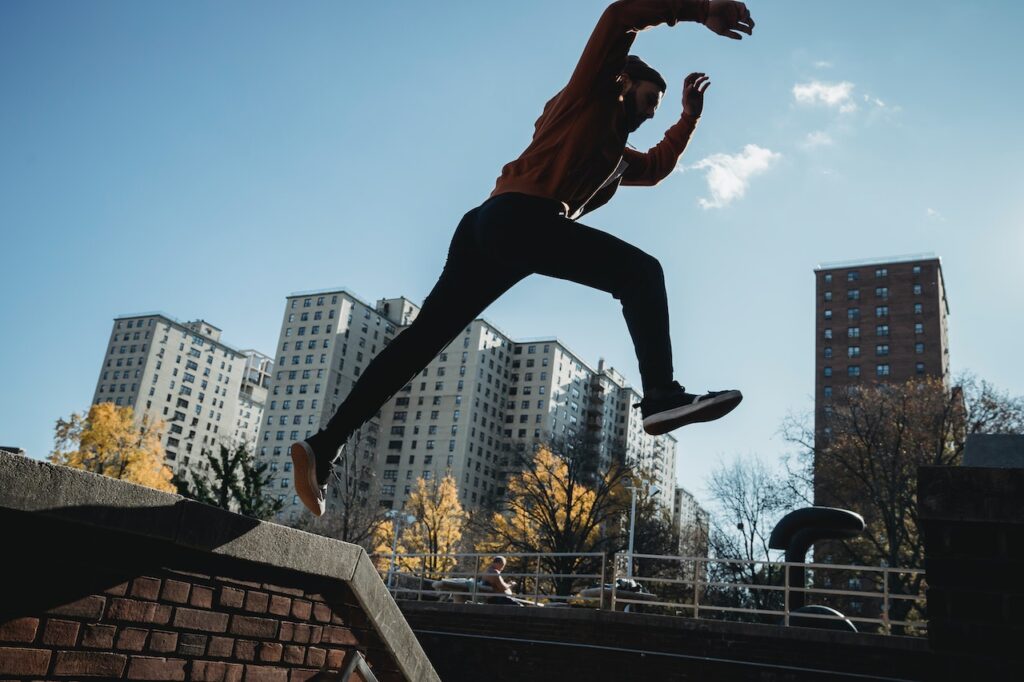
Your Mission
At the end of the 5-day parkour training, you would have practiced four categories of parkour moves: vaulting, jumping, climbing, and rolling. This provides you with a nice toolbox to play around with obstacles at a basic level. These skills can be used in obstacle races and may, in some cases, save your life.
Safety
While parkour is thrilling, safety should always be a top priority. Here are some tips to keep in mind:
- Know Your Limits: Don’t attempt advanced moves until you’ve mastered the basics. Progress at your own pace to avoid injury.
- Use Proper Technique: Focus on form and technique to ensure you’re executing movements correctly and safely.
- Train with Others: Whenever possible, train with a partner or group. They can provide assistance, feedback, and help in case of an emergency.
- Choose Safe Environments: Practice in areas that are free from hazards. Avoid slippery surfaces, sharp edges, and unstable structures.
- Warm Up and Cool Down: Always begin with a proper warm-up to prepare your body for physical activity and end with a cool-down to aid recovery.
Realistic Progress
Mastering complex parkour moves in a short time can be overwhelming. Focus on making steady progress rather than achieving perfection immediately. For example, instead of mastering wall runs in a day, aim to feel comfortable with the basic technique and height. Celebrate small successes to stay motivated.
Training Session Duration
Each session should last about 60 – 75 minutes, including warm-up and cool-down periods. This structure ensures a comprehensive workout without overwhelming beginners.
While the training is meant to run consecutively, you are free to adjust the frequency to you schedule.
Tips when you’re training Alone…
Stay motivated – Training alone requires self-discipline. Set clear, achievable goals for each session and track your progress. Reward yourself for meeting milestones to stay motivated.
Manage the anxiety of people watching you – It’s natural to feel self-conscious when practicing in public. Focus on your training and remember that most people are curious and impressed, not judgmental. Find less crowded locations or train with a friend if you feel uncomfortable.
Create a Supportive Environment – Create a routine that includes motivational music, a designated training area, and regular practice times. Join online parkour communities for support and feedback.
2 – 5-Day Parkour Quick Beginner Training Guide

Guidelines for Each Day & Rest time between sets
- Warm-up: 6 minutes of dynamic stretching or light cardio to prepare the body.
- Strength Training: 15 minutes of basic exercises to build foundational strength. Aim for 1-2 minutes of rest between sets. This allows enough time for muscles to recover partially so you can perform the next set effectively.
- Flexibility: 6 minutes of stretching to improve range of motion and prevent injuries. Rest periods between flexibility exercises are typically shorter, around 30 seconds to 1 minute, as these exercises focus more on maintaining range of motion and avoiding stiffness.
- Basic Movement Practice: 20 to 45 minutes of practicing a specific parkour move with clear milestones and progress markers.
Day 1: Foundation (Precision Jump & Safety Roll)

Estimated Training Time: 60 minutes
- Warm-up (6 min)
- Strength training (15 min)
- Flexibility (6 min)
- Parkour Move: Precision Jumps (15 min)
- Parkour Move: Safety Rolls (15 min)
Warm-up (6 minutes)
| Exercise | Description | Duration |
|---|---|---|
| Arm circles | Stand tall, extend arms to sides, make circles. Increase size gradually. Reverse direction halfway. | 2 min |
| Leg swings | Stand on one leg, swing other leg forward/backward. Switch legs. | 2 min |
| Torso twists | Stand with feet shoulder-width apart, twist torso left/right. | 2 min |
Strength Training (15 minutes)
| Exercise | Sets | Reps | Rest |
|---|---|---|---|
| Push-ups | 3 | 5-10 reps | 60 sec |
| Squats | 3 | 10 reps | 60 sec |
| Planks | 3 | 15-30 secs | 60 sec |
Flexibility (6 minutes)
| Stretch | Description | Duration |
|---|---|---|
| Hamstring stretch | Reach towards toes | 2 min |
| Quad stretch | Pull foot towards glutes | 2 min |
| Shoulder stretch | Cross arm over chest | 2 min |
Basic Movement: Precision Jumps (15 min)
Precision jumps are fundamental in parkour, focusing on accuracy and balance. This exercise helps build confidence in landing and improves spatial awareness.

Goal:
- Successfully land on the target without stumbling or losing balance.
- Aim to achieve a stable landing in the first session. There is no point compromising balance for distance.
Setup:
- Choose a target that is 1-2 feet away, appropriate for beginners.
- Ensure the landing area is clear of obstacles and safe for landing.
Execution:
- Approach the target with a controlled run-up.
- Jump explosively, aiming to land softly and precisely on the target.
- Use both feet to land simultaneously on the target.
Technique Tips:
- Maintain a straight posture throughout the jump to aid balance and control.
- Focus on landing with bent knees to absorb impact smoothly.
- Keep your eyes focused on the landing spot to enhance accuracy.
Basic Movement: Safety Rolls (15 min)
Safety rolls are essential for learning how to fall safely and reduce impact during parkour movements.
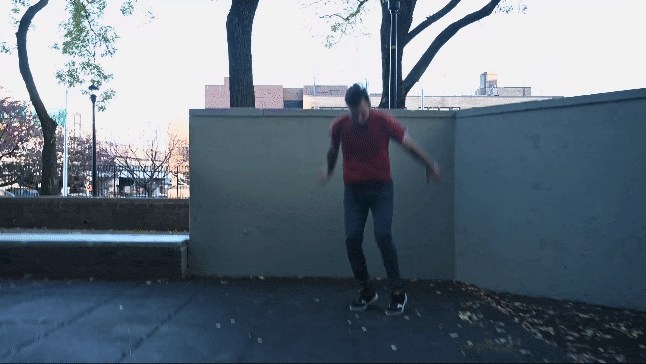
Goal:
- Perform the roll without hesitation or impact on the ground.
- Aim for a fluid and controlled roll from start to finish.
- Being able to roll from a squatting position is good enough for the first session.
Setup:
- Find a clear, soft surface such as grass or a gym mat.
- Ensure there are no obstacles in the rolling path.
Execution:
- Start in a squatting position, feet shoulder-width apart.
- Tuck your head towards your chest and roll diagonally over one shoulder.
- Use your arms to protect your head and distribute impact along your back.
Technique Tips:
- Maintain a smooth, continuous motion throughout the roll.
- Keep your chin tucked to avoid hitting your head.
- Roll over the shoulder, not directly on the spine.
- Practice slowly at first, then gradually increase speed.
- Practice rolling from both sides to develop versatility and comfort. But as a beginner, it’s normal to be better on one side than the other.
Day 2: Vaulting & Safety Roll

Estimated Training Time: 60 minutes
- Warm-up (6 min)
- Strength training (15 min)
- Flexibility (6 min)
- Parkour Move: Safety Vault (20 min)
- Parkour Move: Safety Rolls (10 min)
Warm-up (6 minutes)
| Exercise | Description | Duration |
|---|---|---|
| Jogging | Light jog to increase heart rate | 6 min |
Strength Training (15 min)
| Exercise | Sets | Reps | Rest |
|---|---|---|---|
| Dips | 3 | 5-10 reps | 60 sec |
| Leg raises | 3 | 10 reps | 60 sec |
| Calf raises | 3 | 15 reps | 60 sec |
Flexibility (6 min)
| Stretch | Description | Duration |
|---|---|---|
| Hip flexor stretch | Lunge position, push hips forward | 2 minutes |
| Calf stretch | Lean against wall, press heel down | 2 minutes |
| Triceps stretch | Pull elbow behind head | 2 minutes |
Basic Movement: Safety Vault (15 min)
The safety vault is a fundamental parkour move that focuses on safely and efficiently overcoming obstacles. This exercise helps build confidence in clearing obstacles and improves coordination.
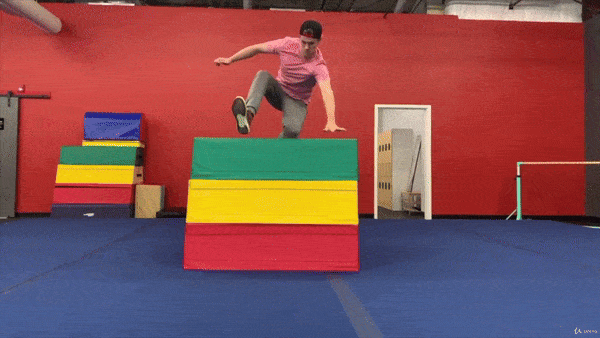
Goal:
- Successfully clear the obstacle smoothly and safely without losing balance or control.
- Aim to achieve a fluid motion with control within the first session.
Setup:
- Choose a low obstacle (such as a low wall or rail) that is stable and safe for practice.
- Ensure the area around the obstacle is clear of hazards.
Execution:

- Approach the obstacle with a controlled jog straight on.
- Plant your lead hand and opposite foot firmly on the obstacle (e.g. right hand and left foot, or left hand and right foot)
- Bring your trailing leg through as your body moves over the obstacle, ensuring it clears smoothly.
- Land softly on the other side, resuming your run smoothly. If you’re comfortable, you can perform a safety roll after this.
Technique Tips:
- Weight Distribution: Your hand and foot should support a significant portion of your weight.
- Soft Landings: Focus on landing with bent knees to absorb impact smoothly.
- Focus: Keep your eyes on the obstacle and landing spot to enhance accuracy and control.
Basic Movement: Safety Rolls (15 min)
At a higher level, safety rolls absorb impact safely and smoothly when you’re transitioning at speed and landing from height. Building the skill to roll and transition into a safety roll is important.
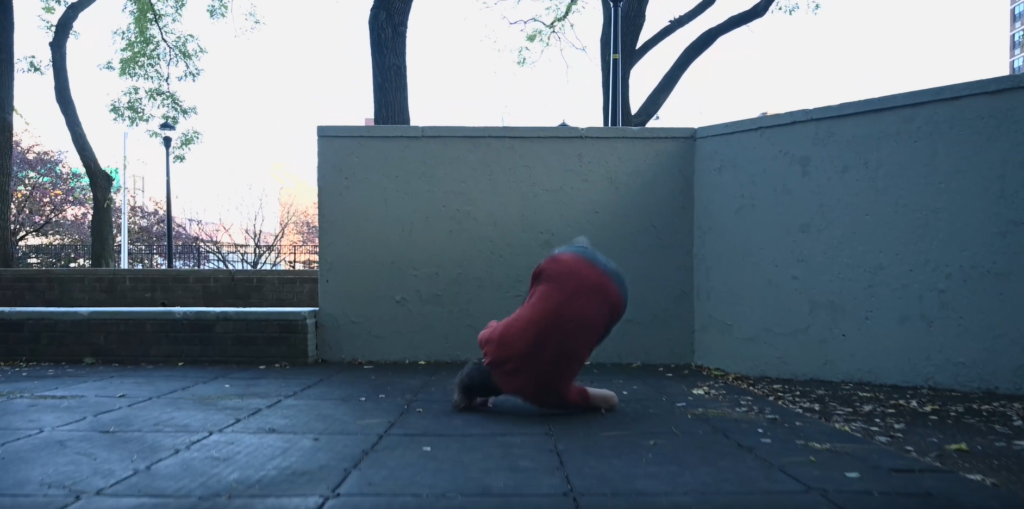
Goal:
- Execute the roll smoothly and seamlessly from different starting positions (e.g. standing, after a precision jump). Do NOT jump from height at this stage.
- Aim for fluidity and control throughout the entire rolling motion.
Setup:
- Find a soft, clear surface such as grass or a gym mat.
- Ensure there are no obstacles in your rolling path.
Execution:
- Begin standing or with a small jump. Then transition into a crouched position, feet shoulder-width apart.
- Tuck your head towards your chest as you initiate the roll over one shoulder.
- Keep your arms close to your body and use them to guide the roll.
Technique Tips:
- Maintain a continuous and controlled motion throughout the roll.
- Practice rolling from various starting positions (standing, kneeling, or crouching) to improve adaptability.
- Focus on landing softly and distributing impact along your back.
Day 3: Basic Climbing Skills + Previous Parkour Moves

Total Training Time: 60 minutes
- Warm-up (6 min)
- Strength training (15 min)
- Flexibility (6 min)
- Parkour Move: Low Wall Climbs (20 min)
- Parkour Move: Choose Your Moves (10 min)
Warm-up (5 min)
| Exercise | Description | Duration |
|---|---|---|
| Jump rope | Light jumping to warm up legs | 5 minutes |
Strength Training (15 minutes)
| Exercise | Sets | Reps | Rest |
|---|---|---|---|
| Pull-ups | 3 | 3-5 reps | 60 sec |
| Bodyweight rows | 3 | 8-10 reps | 60 sec |
| Push-ups | 3 | 5-10 reps | 60 sec |
Flexibility (6 minutes)
| Stretch | Description | Duration |
|---|---|---|
| Groin stretch | Sit with soles of feet together | 2 min |
| Chest stretch | Extend arms behind and lift | 2 min |
| Wrist stretch | Gently pull back on fingers | 2 min |
New Basic Movement: Low Wall Climbs (20 minutes)
Low wall climbs introduce basic climbing techniques and build upper body strength essential for parkour.
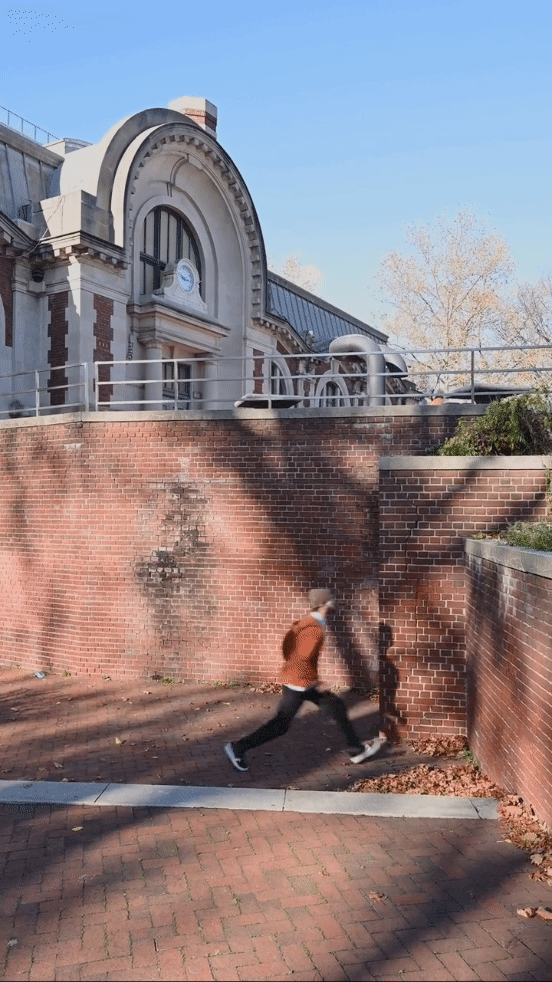
Goal:
- Reach the top of the wall (LOW wall) smoothly without slipping or losing balance.
- Aim for a controlled ascent and descent with each attempt.
Setup:
- Find a low wall or ledge that is stable and safe to climb.
- Ensure there is enough space to maneuver around the wall.
Execution:
- Approach the wall with a steady pace.
- Use a step-up technique by placing one foot on the wall’s edge.
- Follow with a controlled pull-up motion to reach the top of the wall.
Technique Tips:
- Focus on maintaining balance and control throughout the climb.
- Use your legs to push and assist in the upward movement.
- Once your chest is above the wall, lean your body weight over the of the wall to conserve strength. But be careful not to lean excessively that you top over to the other side.
Previous Basic Movements: Your Choice (10 min)
Pick any of the parkour moves you need more practice in and practice the techniques.
Day 4: Practice and Progression
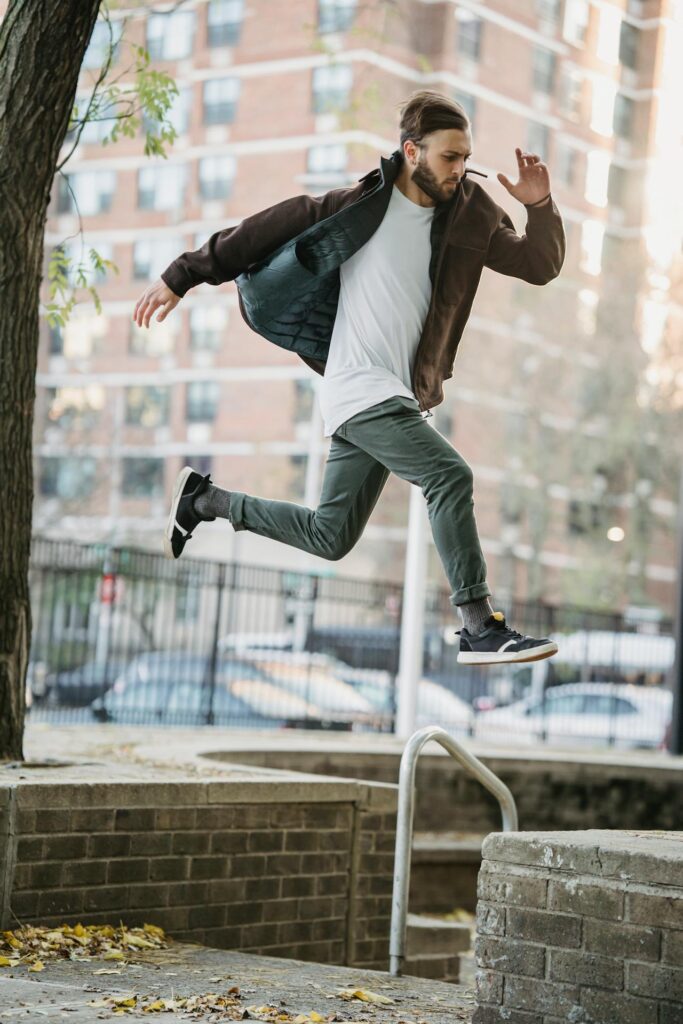
Total Training Time: 60 – 75 min
- Warm-up (8 min)
- Strength training (15 min)
- Flexibility (6 min)
- Parkour: Advanced Practice (30 min)
Warm-up (8 min)
| Exercise | Description | Duration |
|---|---|---|
| Jump rope | Light jumping to increase heart rate | 2 min |
| Arm Circles | Stand tall, extend arms to sides, make circles. Increase size gradually. Reverse direction halfway. | 2 min |
| Leg Swings | Stand on one leg, swing other leg forward/backward. Switch legs. | 2 min |
| Torso Twists | Stand with feet shoulder-width apart, twist torso left/right. | 2 min |
Strength Training (15 minutes)
| Exercise | Sets | Reps | Rest |
|---|---|---|---|
| Pull-ups | 3 | 3-5 reps | 60 sec |
| Lunges | 3 | 10 reps | 60 sec |
| Bicycle kicks | 3 | 15 reps | 60 sec |
Flexibility (6 minutes)
| Stretch | Description | Duration |
|---|---|---|
| Hip flexor stretch | Lunge position, push hips forward | 2 min |
| Calf stretch | Lean against wall, press heel down | 2 min |
| Triceps stretch | Pull elbow behind head | 2 min |
Advanced Practice: Combining Precision Jumps, Safety Vaults, and Rolls (20-30 Min)
Combining moves helps to create fluid sequences, improving the ability to link parkour techniques naturally. If you need more practice with certain parkour moves, make sure to practice.
Goal:
- Integrate precision jumps, safety vaults, and rolls into smooth sequences.
- Develop the ability to transition between different movements with ease.
Setup:
- Arrange obstacles to allow for the combination of movements in a controlled environment.
- Ensure all obstacles are stable and safe.
Execution:
- Start with a precision jump to a designated target.
- Transition smoothly into a safety vault over a nearby obstacle.
- Conclude the sequence with a safety roll upon landing.
Technique Tips:
- Focus on maintaining control and fluidity throughout the sequence.
- Keep movements deliberate and avoid rushing.
- Ensure proper form for each individual move within the combination.
- Practice each sequence slowly at first, then gradually increase speed.
Example Sequences:
- Precision Jump -> Safety Vault -> Safety Roll
- Safety Vault -> Precision Jump -> Safety Roll
- Precision Jump -> Precision Jump -> Safety Roll
Feedback & Self-Assessment:
- Reflect on each sequence and identify areas for improvement.
- Adjust form and technique as needed based on self-assessment.
- Aim for consistent improvement in fluidity and control over time.
Day 5: Flow Practice

Total Training Time: 60 – 75 min
- Warm-up (6 min)
- Strength training (15 min)
- Flexibility (6 min)
- Parkour: Flow Practice (30 min)
Warm-up (6 min)
| Exercise | Description | Duration |
|---|---|---|
| Jump rope | Light jumping to increase heart rate | 3 min |
| Dynamic stretches | Full body stretches (arm circles, leg swings, twists) | 3 min |
Strength Training (15 min)
| Exercise | Sets | Reps | Rest |
|---|---|---|---|
| Push-ups | 3 | 5-10 reps | 60 sec |
| Squats | 3 | 10 reps | 60 sec |
| Planks | 3 | 15-30 sec | 60 sec |
Flexibility (6 min)
| Stretch | Description | Duration |
|---|---|---|
| Hamstring stretch | Reach towards toes | 2 min |
| Quad stretch | Pull foot towards glutes | 2 min |
| Shoulder stretch | Cross arm over chest | 2 min |
Flow Practice: Putting It All Together (45 Min)
Flow practice involves creating smooth transitions between different parkour techniques, focusing on fluidity and creativity.
Goal:
- Integrate all learned movements into seamless flow sequences.
- Develop personal style and creativity in movement.
Setup:
- Use a variety of obstacles to allow for diverse sequences.
- Ensure the training environment is safe and free from hazards.
Execution:
- Start with a basic movement, such as a precision jump.
- Transition into a safety vault, followed by a roll.
- Continue the sequence with additional movements, experimenting with different combinations.
Technique Tips:
- Focus on maintaining continuous movement without pauses.
- Experiment with different sequences to find what feels natural.
- Prioritize safety and control over speed.
Example Sequences:
- Precision Jump -> Safety Vault -> Roll -> Precision Jump
- Safety Vault -> Precision Jump -> Roll -> Safety Vault
- Roll -> Precision Jump -> Safety Vault -> Roll
Feedback & Self-Assessment:
- Reflect on each flow sequence and identify areas for improvement.
- Adjust form and technique as needed based on self-assessment.
- Aim for consistent improvement in fluidity and creativity over time.
This 5-day program is designed to provide beginners with a strong foundation in parkour, building the skills and confidence needed to progress to more advanced techniques.
3 – Ready to Level Up Your Skills?
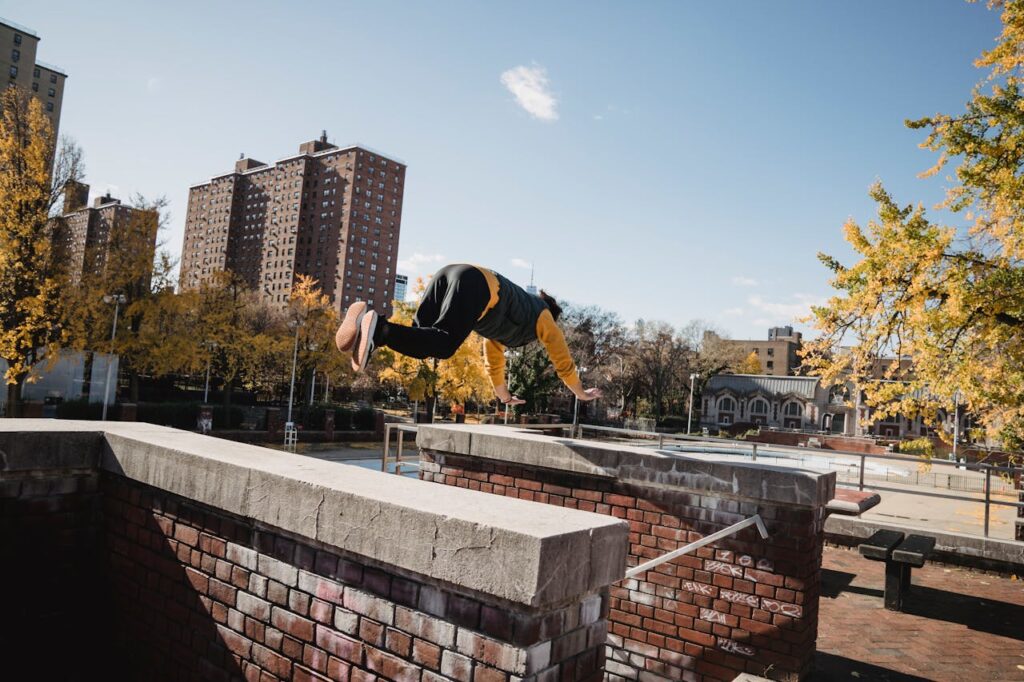
Completed the 5-Day Parkour Quick Training Guide? You’ve taken the first steps towards mastering the basics of parkour, building your strength, agility, and confidence. Now, it’s time to elevate your training and fully embrace the path of the modern ninja.
Introducing The Comprehensive Parkour Program
Our partner’s highly-rated program, Learn Parkour And Free Running – Basic to Intermediate Skills, is designed to take your training to the next level. This program aligns perfectly with the Way of Ninja philosophy, focusing on developing cross-functional skills that will transform you into a modern-day ninja.
Here’s what you can expect:
- Dynamic Techniques: Learn amazing parkour techniques safely from the comfort of your backyard. From shoulder rolls to balance work, and from vaulting to wall techniques, this course covers it all.
- Flips and Tricks: Master the art of backflips, wall flips, front flips, and butterfly kicks, ensuring you’re ready to tackle any challenge with ninja-like precision.
- Professional Feedback: Get expert feedback on your training videos from a team of experienced parkour coaches. This personalized guidance will help you refine your skills and progress faster.
- Lifetime Access: Enjoy full lifetime access to the course materials, including 4 hours of on-demand video, assignments, and articles, accessible on mobile and TV.
- Community Support: Join a member’s-only community where you can connect with fellow parkour enthusiasts, share your progress, and get additional tips and motivation.
Join the Program Today!
By enrolling in the comprehensive Learn Parkour And Free Running – Basic to Intermediate Skills program, you’re investing in a unique training experience that will set you on the path to becoming a modern ninja. Whether you’re a beginner looking to build a solid foundation or an athlete seeking to cross-train and enhance your performance, this course is perfect for you.

